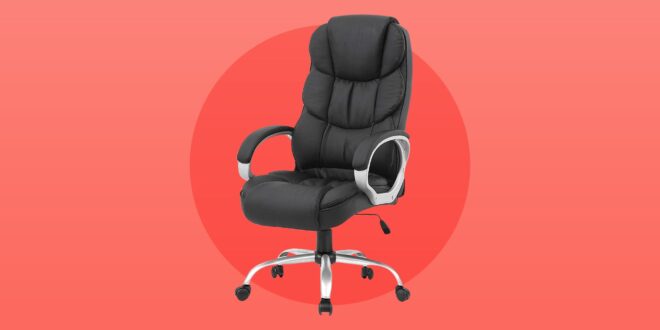What does it take for an office chair to be both comfortable and ergonomic? At first glance, comfort and ergonomics might sound like two mutually exclusive concepts – like an office chair that’s so soft you sink into it, but won’t provide you with the support you need. But really, the best of both worlds is achievable!
Here, we’ll discuss the best office chairs for both comfort and ergonomics – and why they’re the perfect fit for your desk. We’ll also provide some tips on choosing the comfiest office chair and making it as ergonomic as it can be. So if you’re looking for the ideal chair to upgrade your workspace, read on!
When looking for the best office chair, it is important to consider ergonomic benefits since many office workers will be sitting for extended periods of time. Ergonomic chairs are designed so that they can provide a comfortable and supportive seating position in order to reduce pressure points on the spine and encourage better posture. This improved posture can decrease fatigue as well as increase productivity, concentration, and overall comfort.
The debate between proponents and opponents of ergonomic office chairs centers on whether or not an ergonomically designed chair offers enough support to prevent back issues. Proponents argue that a properly designed ergonomic chair should help maintain the natural curve of the spine when seated and give great support to both the upper and lower back. They also point out that ergonomic chairs with adjustable features make it easy to customize the chair in order to fit a variety of body types, making it ideal for those with physical impairments such as neck, back or shoulder pain.
On the other hand, opponents suggest that no matter how ergonomically designed an office chair may be, it cannot replace the importance of proper movements, exercise, and stretches throughout the day in order to keep your body healthy. In addition, many argue that there is no single “ideal” seating position when it comes to preventing posture-related injuries; thus no single type of chair can provide adequate protection against all kinds of body discomfort.
Regardless of personal opinions on this subject, ergonomic chairs can be beneficial when paired with other methods intended to promote healthy physical habits while at work. In the next section, we’ll look at what makes an office chair ergonomic and discuss some of its features in more detail.
Table of Contents
What Makes an Office Chair Ergonomic?
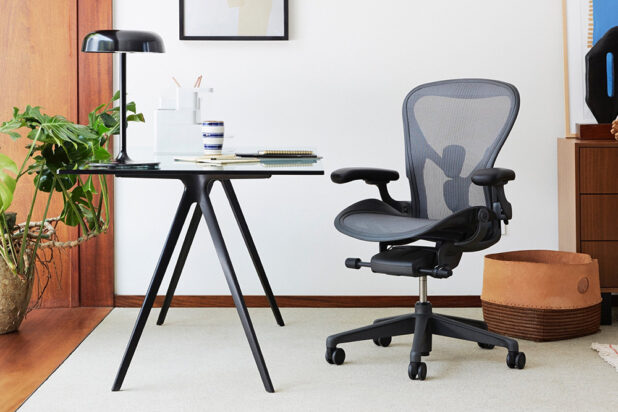
When it comes to office chairs, ergonomics is an important factor in finding the right fit. Ergonomics is all about achieving maximum comfort and productivity in a workspace by optimizing the physical environment and minimizing potential workplace injuries. The goal of an ergonomic office chair is to provide the support that allows individuals to work in a position that minimizes fatigue and discomfort while also supporting their spine and other areas of the body.
An ergonomic office chair should provide good posture, adequate back support, adjustable armrests, adjustable seat depth/tilt, and adjustability for lumbar support. It should also be lightweight yet stable, have a comfortable backrest shape, and sturdy base, have well-padded arms for armrests, an adjustable height mechanism with tension control for its backrest movement, and adjustable lockable castors that allow for easy movement.
These elements are essential for any ergonomic office chair to adequately provide proper body support and reduce stress on the neck and spine. Some people may argue that ergonomics alone cannot guarantee adequate comfort when selecting an office chair since personal preferences also play a role in determining overall comfort. That said, even with personal preferences taken into account, an ergonomic office chair still offers greater levels of support and comfort than any non-ergonomic alternative. Regardless of how much padding or cushioning one prefers on their office chair, if the underlying structure isn’t providing adequate ergonomic support it can still lead to fatigue over time.
For that reason, regardless of what other features you prefer in an office chair, having effective ergonomics should come first since it will ultimately be more beneficial in the long run. As such, finding the right combination of both ergonomics and comfort is key when selecting an office chair. In the next section, we will consider what factors to look for when selecting an office chair that provides both ergonomics as well as comfort.
Ergonomics and Comfort

Ergonomics and comfort are two of the key features to look for in an office chair. Ergonomics refers to chairs specifically designed to reduce the physical stress imposed on users. Ideally, you want an ergonomic office chair that can be adjusted so that its height, depth, and back support fit your body’s form perfectly. A good ergonomic chair helps alleviate muscular tension due to poor posture by supporting your back and hips with correct alignment. It will also provide adequate lumbar support to reduce strain on the lower back muscles, keeping you comfortable throughout your workday.
Additionally, adjustable armrests enable users to adjust the height and distance of the armrests from their bodies, providing customized comfort and support. In terms of comfort, a good-quality office chair should offer padded seat cushions with enough padding to provide pressure relief while still maintaining a supportive feel. Upholstery material should be breathable and have some give so it conforms to the contours of your body over time.
The material should also be easy to clean since you will likely spend several hours in the chair each day. It is also important that the chair allows for proper circulation within the legs and hips as this can promote comfort during long periods of sitting.
Ergonomics and comfort need to be carefully balanced out in order to choose the perfect office chair for you. When making a decision look for a product that can accommodate both of these principles for optimal results. The next section will discuss how adjustable armrests and lumbar support can contribute to enhanced ergonomics and comfort levels when seated in an office chair.
- According to a study conducted by Cornell Ergonomics, adjustable lumbar support, cushioned backrests, and armrests are essential features for comfort in an office chair.
- A study published by California State University in 2017 found that adjustable seat height and tilt tension can reduce strain on the lower back while sitting.
- Research conducted by the American Occupational Therapy Association found that chairs with good lumbar support can significantly reduce discomfort in the lower back region while working.
Adjustable Armrests and Lumbar Support
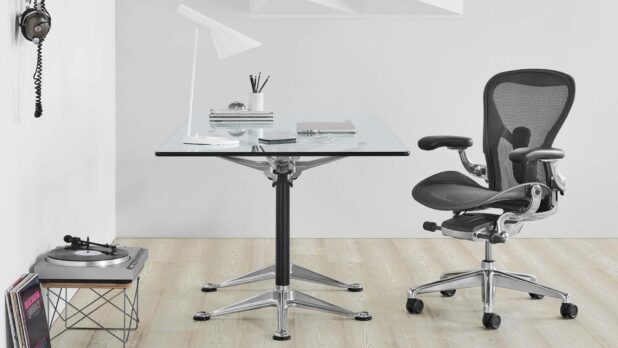
Armrests and lumbar support are key features of an ergonomic office chair, as they help to improve posture and reduce pressure when you’re sitting for extended periods of time. Adjustable armrests and lumbar supports are beneficial because they provide customizable support based on your body’s needs. With adjustable armrests, you can get optimal positioning for both your arms and shoulders which can lead to better alignment throughout the body.
Similarly, adjustable lumbar supports help relieve stress from the spine by offering additional support to the lower back. When shopping for an office chair with adjustable armrests and lumbar support, be mindful of how easy it is to adjust each feature. If it is difficult or time-consuming to adjust the settings, chances are you won’t move them as often as you should in order to stay comfortable during prolonged sitting sessions.
Look for a chair with adjustments that are simple and fast so that you can make changes quickly throughout the day as needed. Although not necessary for all users, adjustable armrests and lumbar support are important features if you need extra customization to obtain maximum comfort while working.
This type of office furniture may be more expensive than standard models, but could be worth the investment in long-term comfort, improved posture, and increased productivity. Now that we’ve reviewed the benefits of adjustable armrests and lumbar support in an office chair, let’s look at choosing the right one for your needs in the next section.
Choosing the Best Office Chair for Your Needs
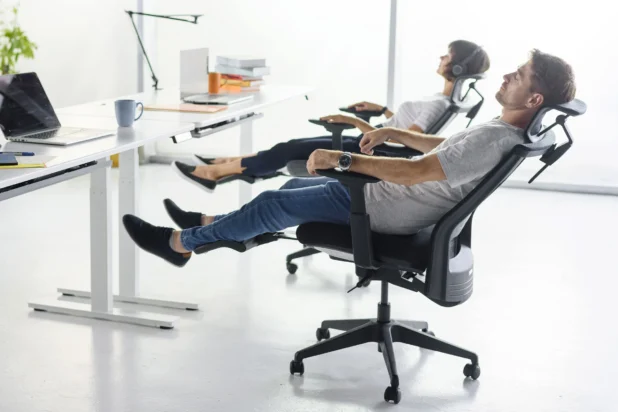
Choosing the best office chair for your needs is a decision that should be taken seriously. Sitting in an uncomfortable and unsupportive chair can cause various health issues, including neck and back strain, poor posture, leg circulation problems, and shortened attention spans due to fatigue. It’s essential to find an office chair that offers the right combination of support, comfort, and ergonomic design in order to maintain good posture and promote maximum productivity throughout the day.
When choosing an office chair, different factors must be considered depending on your particular needs.
Comfort is a top priority for many people – cushions or backrests are important for remaining comfortable as you work. On the other hand, if breathability is more important to you than cushioning, look for mesh chairs with inherent ventilation to prevent perspiration buildup.
Additionally, think carefully about choosing a desk chair with adjustable features like armrests, height settings, tilt levers, lumbar support, headrests, and even footrests —all of these are especially useful when working long hours at a computer station.
In terms of ergonomics, there are also some key points to consider when selecting the perfect office chair for you. The primary focus should be on the curvature of the seat; contoured seats provide posture support and help by evenly distributing body weight throughout its surface area. You’ll also want to make sure that your feet are flat on the ground or have enough room beneath you so as not to interfere with circulation in your legs.
Lastly, always look for an adjustable headrest if planning to spend lengthy periods of time sitting in the office chair – this feature relieves stress from your upper neck by supporting your head while reclining or sitting upright without having to lift up your chin unnecessarily. Ultimately choosing the perfect office chair depends on personal preference and what features prove most beneficial for whatever tasks will be completed while using it.
Consider all factors before making a decision as it is one of the most important pieces of furniture in any workspace. Now let’s look into how important it is to ensure that your chosen chair is compatible with your desk.
Compatibility With Your Desk
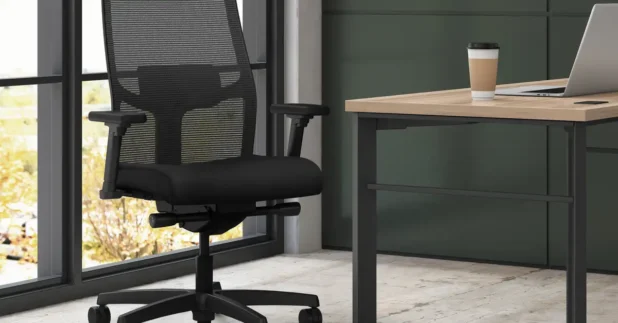
When selecting an office chair for optimal comfort and ergonomics, it is important to consider compatibility with your desk. An ergonomic office chair should provide support for the upper and lower back and allow for movements such as a backward tilt of the chair away from the desk. Ideally, your chosen office chair should be adjustable in height to correspond with the height of your individual workspace.
In some cases, depending on the size of your workspace, desks are not adjustable. This may lead to trouble finding a comfortable fit between the height of your desk and that of your chair. If both the desk and chair are adjustable, there will be no issue as you can match both surfaces accordingly to your own needs quickly and easily.
However, if it is only possible to adjust one or none of these pieces of furniture, then it is important to choose an office chair that is compatible with the fixed height of your desk. In this case, it may require some research into available features to find a chair that corresponds with the height of your desk as accurately as possible. This often means finding a suitable seat depth and armrest setup is also important when working with fixed desks.
Finally, once you have confirmed compatibility between your desk and an appropriate office chair, it is time to consider another critical factor: adjustable heights. The ability to adjust an office chair’s position can bring immediate comfort and safety benefits when sitting at a workstation. The next section of this article will focus on how adjustable heights affect comfort and usability in office chairs.
Key Takeaways
It is important to consider the compatibility of an ergonomic office chair and your desk when selecting an office chair for optimal comfort and ergonomics. Adjustability is key when it comes to finding a comfortable fit between the height of your desk and that of your chair. If both the desk and chair are adjustable, this can be easily done.
However, if only one or neither of these pieces of furniture can be adjusted, it is important to choose a compatible office chair with regard to height. Lastly, adjustable heights in office chairs are important for comfort and safety benefits while working at a workstation.
Adjustable Heights
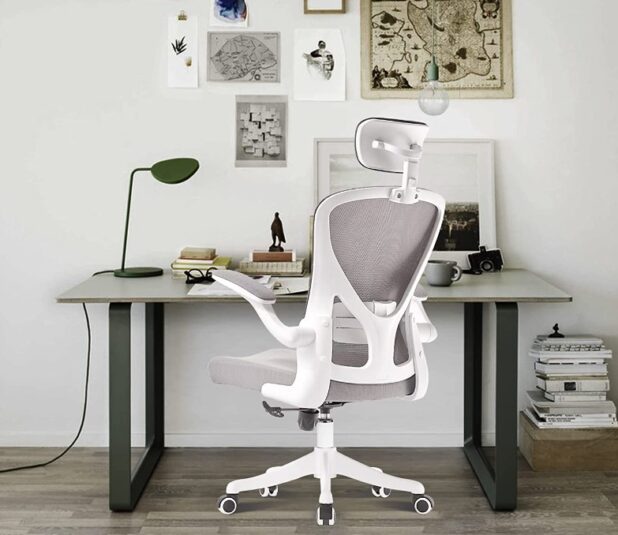
When it comes to choosing the best office chair for comfort and ergonomics, adjustable heights are an important factor to consider. While any chair can be maneuvered around to some degree, adjustable chairs dynamically move in height to provide extra comfort and support. This feature helps when working with a variety of tasks that require different postures or viewing angles so users can customize their chairs from sitting upright to reclining back.
The real debate when it comes to adjustable heights is whether the chair should be manual or automatic. Manual chairs offer cost-effective modifications and generally have an easy-to-reach adjustment lever that moves the seat up and down. They are typically durable and built with steel frames. On the other hand, automatic chairs offer touchpad controls, sliding and reclining capabilities, as well as air compressor-like systems that adjust based on pressure. These flexible and uncommon features make them ideal for individuals who value convenience but they can often be quite expensive.
Ultimately, there is no “right” answer when determining which style of adjustable chair is best, since both options offer different benefits. Finding the right fit depends on budget limitations and personal preferences; it helps to understand one’s own needs before considering either choice. Now that you know more about adjustable heights when searching for the ideal office chair for comfort and ergonomics, let’s take a look at material quality and design in the following section.
Material Quality and Design
When it comes to office chairs, the material quality and design play a critical role in both ergonomics and comfort. A well-designed chair should provide optimal support for the user’s posture and movements. Additionally, good quality materials should last longer and remain comfortable over time. For maximum support, look for chairs made out of durable materials like leather or mesh that are designed with lumbar support and adjustable features such as tilt tension control and headrests. When choosing an office chair, make sure that it has adjustable armrests and height levels for added comfort when working for long hours – this usually indicates higher-quality construction.
The fabric material is also an option but may not provide the same level of support as other materials. On the other hand, it is not necessary to buy an expensive chair to obtain the desired ergonomic optimization and comfort. There are cost-effective models available on the market that offer great value and still provide adequate design and support – choose wisely depending on your budget needs.
Finally, good office chairs should also include aesthetic touches like interesting colors or patterns to match any work area without compromising on performance.No matter what type of material or design you choose for your office chair, it is important to find one that suits your individual needs in terms of comfort, ergonomic support, and looks.
Picking the right chair can have a direct impact on your body; therefore, investing time in researching various options will pay off in the long run. In the next section, we will discuss how sitting in the right chair can benefit your health and well-being.
How Sitting in the Right Chair Benefits Your Body
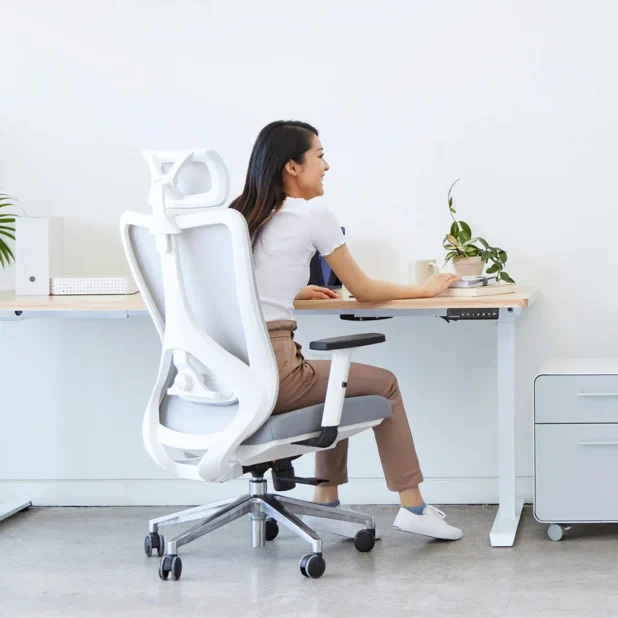
Sitting in the right office chair is essential for minimizing long-term aches, pains, and fatigue due to long hours spent at work. The right desk chair can benefit your body by improving posture, reducing spinal compression, and providing cushioning support to reduce strain on pressure points.
Ergonomically designed chairs are a great way to improve your sitting posture. An ergonomic chair should be adjustable to fit your body size and shape while providing lumbar support to keep your back upright and ensure proper alignment of your neck and spine. Properly adjusted, an ergonomic chair can help you maintain a neutral posture, not just during the workday, but even afterward. This means less muscle tension, improved circulation, better clarity of thought, more energy throughout the day, and decreased stress levels.
However, there are arguments against using ergonomic chairs as well. Some studies suggest that using an ergonomic chair instead of a traditional one could increase pressure on hip joints and decrease spine mobility due to how it restricts movement during the course of the day. Additionally, there may be other lifestyle factors that need to be addressed such as regularly taking breaks from sitting or exercising throughout the day before investing in an ergonomic chair.
No matter what type of chair you choose – from an expensive ergonomic recliner to a basic office chair – it’s important to take regular breaks from sitting throughout the day and practice good sitting posture regardless of what type of chair you have. Doing this will help ensure that whichever desk chair you select gives you maximum comfort and benefits for your body.In conclusion, having the right office chair can have a positive impact on both physical and mental health. When selecting the right office chair for yourself or your employees, the most important considerations are adjustable seat height and lumbar support that works with your body type while still allowing free movement throughout the day. The next section will cover tips for finding the best option office chair for comfort and ergonomics.
Conclusion
Having the right office chair can be key to increasing productivity and preventing back or neck strain that leads to ailments. The chair should be adjustable, supportive, and comfortable to your body profile and needs.
By following guidelines for ergonomics, office employees can achieve the correct posture for their working environment. When choosing a chair, there are a few factors to take into account: adjustability (height, armrests, headrest), materials used in construction (seat cushioning and frame durability), lumbar support (including any additional features such as a lumbar inflator), stability of base and casters/wheels, and design aesthetic.
There is no single ‘best’ chair since everyone will have different preferences; each person must make a personal assessment of their own needs within the parameters of their respective budget. Chairs range from relatively inexpensive mesh options to high-end ergonomic models with all the bells and whistles. Ultimately, usability will determine which model best fits your environment, but an ergonomic office chair purchased on its own or as part of an office furniture package will provide you with years of comfort, support, and productivity.
 World Magazine 2024
World Magazine 2024
